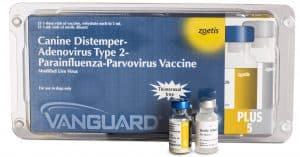In our previous post, we delved into rabies vaccination and discussed why it is the single most important vaccine to administer to your pet. Now, we will go into further detail about the other core vaccination that is recommended for your dog. Although it is more commonly known as just the distemper shot, this vaccination actually protects against four viral agents that threaten our furry companions.
DAPP (Distemper, Adenovirus-2, Parvovirus and Parainfluenza)
This vaccination is considered to be the only other core vaccine besides rabies. Therefore, it is recommended for every dog, regardless of their age, lifestyle, breed or sex.
 Canine Distemper
Canine Distemper
This is a viral disease that attacks the respiratory, gastrointestinal and neurological systems of dogs. Dogs become exposed through airborne particles, infected water and food bowls, and infected dogs can pass the disease to their puppies through the placenta. The first sign of infection is discharge from their eyes progressing to nasal discharge, cough, fever, lethargy, and vomiting. Once the virus starts affecting the nervous system, clinical signs involve circling, muscle twitches, salivation and jaw chewing, seizures, and paralysis. There is no cure and dogs often die from distemper despite supportive care. Those that survive are usually left with permanent nervous system damage.
Canine Adenovirus-2 (CAV-2)
CAV-2 is a virus that attacks the respiratory system and is one of the causative agents in the disease commonly called “kennel cough.” It is usually passed through the air due to coughing dogs and clinical signs including a dry hacking cough, retching, gagging, fever, and nasal discharge develop after 3-10 days. Treatment generally consists of only supportive care, as there is no cure. The infection is generally self limiting, although pneumonia can sometimes develop. Vaccination against Adenovirus-2 is also cross protective against Adenovirus-1 (CAV-1) – the more serious viral type and fatal cause of infectious hepatitis. CAV-1 is passed through ingestion of infected feces, urine or saliva. Clinical progression ranges from slight fever to death with higher mortality rates (up to 30%) seen in young dogs.
 Parvovirus
Parvovirus
Parvovirus (or “parvo”) is an extremely contagious virus with puppies younger than four months being the most at risk for infection. The virus attacks the gastrointestinal tract of dogs. It is spread through direct dog-to-dog contact and contact with contaminated feces. The virus is very hardy and resistant to heat, cold, humidity and drying, meaning it can survive in the environment for a long time. Clinical signs of a dog with Parvovirus include lethargy, anorexia, abdominal pain, vomiting, and severe diarrhea that can quickly dehydrate the animal. Treatment is supportive nursing care and most puppies will die within 48-72 hours after the onset of these clinical signs, so quick onset of treatment is key.
Parainfluenza
Canine parainfluenza is another highly contagious virus that affects the respiratory tract of dogs. It is another common causative agent of infectious tracheobronchitis, aka “kennel cough.” The virus is transmitted through the air and can spread rapidly in shelters or kennels where many dogs are housed together. It is excreted from the respiratory tract for up to two weeks after infection. Clinical signs include lethargy, anorexia, cough, nasal discharge and low grade fever. Luckily, infection is often self-limiting and hospitalization rarely required.
 Vaccination Guidelines
Vaccination Guidelines
Vaccination begins as early as six weeks of age in dogs. Puppies are given the vaccination every 2-4 weeks until they are 16-20 weeks of age. These vaccines administered before 16 weeks of age protect puppies while they are young and their immune systems immature. Older dogs (>20 weeks of age) without a history of the vaccination only require one initial dose and, if deemed at high risk of exposure, a booster 2-3 weeks later. A single dose of the vaccine is administered one year after the initial vaccination series and subsequent boosters typically given at intervals of 3 years.


 Parvovirus
Parvovirus Vaccination Guidelines
Vaccination Guidelines